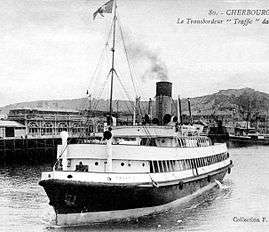SS Traffic (1911)
 | |
| History | |
|---|---|
| Name: | SS Traffic |
| Owner: |
|
| Operator: | Owner operated |
| Port of registry: | Liverpool |
| Builder: | |
| Yard number: | 423 |
| Laid down: | 22 December 1910 |
| Launched: | 27 April 1911 |
| Completed: | 27 May 1911 |
| Maiden voyage: | May 31, 1911 |
| In service: | 27 May 1911 |
| Renamed: | Ingenieur Reibell |
| Fate: |
|
| General characteristics | |
| Tonnage: | 675 tons |
| Length: | 175 ft (53.3 m) |
| Beam: | 35 ft (10.7 m) |
| Decks: | 2 |
| Propulsion: | 2 double expansion engines powering 2 triple blade propellers. |
| Speed: | 12 knots (22 km/h; 14 mph) |
| Capacity: | 1,200 passengers and mail |
SS Traffic was a tender of the White Star Line, and the fleetmate to the SS Nomadic. She was built for the White Star Line by Harland and Wolff, at Belfast, to serve the luxury Olympic-class ocean liners. SS Traffic ferried some of the third class passengers to RMS Titanic for her maiden voyage. She served as a tender for White Star, and supported troop ships during the First World War. After the war she was sold to Société Cherbourgeoise Transbordement, and later renamed Ingénieur Reibell. She was scuttled by the French as the Germans invaded in 1940, but was salvaged and used by the Germans as an armed coastal vessel until being sunk for a final time by the British in 1941.
Early life serving Olympic & Titanic
Harland and Wolff laid down Traffic's keel on 22 December 1910 and launched her on 27 April 1911, two days after her running mate, Nomadic. The vessel then underwent sea trials on 18 May 1911, before being handed over to the White Star Line on 27 May 1911. Two days later, on 29 May, Nomadic and Traffic attended RMS Olympic as she carried out her sea trials. The two tenders then sailed to Southampton, and then on to Cherbourg, where they were based. Traffic carried third class passengers, as well as mail, cargo and baggage, out to the White Star Line's large ocean liners, while Nomadic carried first and second class passengers. Traffic took passengers and mail out to Titanic on 10 April 1912 while the liner lay moored in the roads off the port, preparatory to beginning her maiden voyage across the Atlantic. Traffic could accommodate 1,200 third-class passengers, considerably more than Olympic and Titanic's actual third-class passenger capacity. Despite this, Nomadic also had a small third-class area below deck to accommodate for Traffic's over-spill of passengers.
Wartime and postwar
Traffic continued as a tender during the First World War, servicing the troop transports and carrying British, American and Canadian troops. Traffic and Nomadic were sold to Société Cherbourgeoise Transbordement in 1927, and continued to serve as tenders, but now called on any large vessels using the port. Traffic accidentally collided with RMS Homeric on 5 June 1929, and sustained some damage to the starboard side of the hull. After enquiries revealed that Traffic was notoriously difficult to handle, new propellers were produced by Harland and Wolff and fitted in October 1929. Despite proving effective, Traffic was involved in another collision in December 1929, this time involving SS Minnewaska, of the Atlantic Transport Line. There was only minor damage. Minnewaska was involved in another collision two years later, this time with Nomadic on 29 November 1931, during which Nomadic's bow was damaged. Nomadic and Traffic's owners became Société Cherbourgeoise de Remorquage et de Sauvetage in 1934, and both ships were repainted in the new livery and renamed, Traffic becoming Ingénieur Riebell and Nomadic Ingénieur Minard.
Second World War and loss
During the Second World War, as the Germans invaded France, Ingénieur Riebell was scuttled by the French Navy off Cherbourg on 17 June 1940, in an attempt to block the port and deny her to the Germans. She was subsequently salvaged by the Germans and used as an armed coastal vessel. She was torpedoed and sunk by the Royal Navy while serving in this capacity, on 17 January 1941. The location of her wreck is currently unknown.